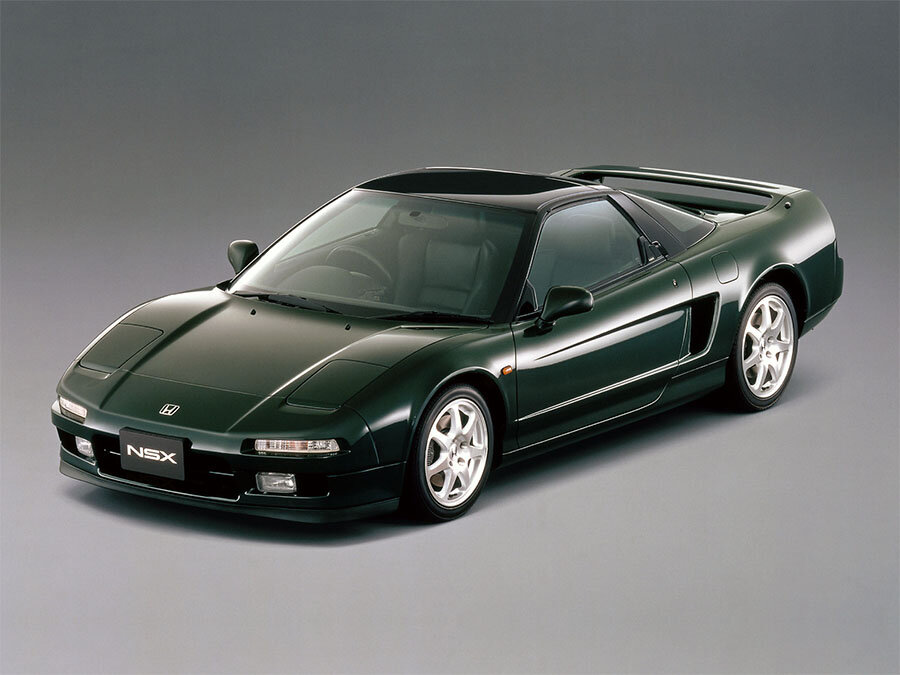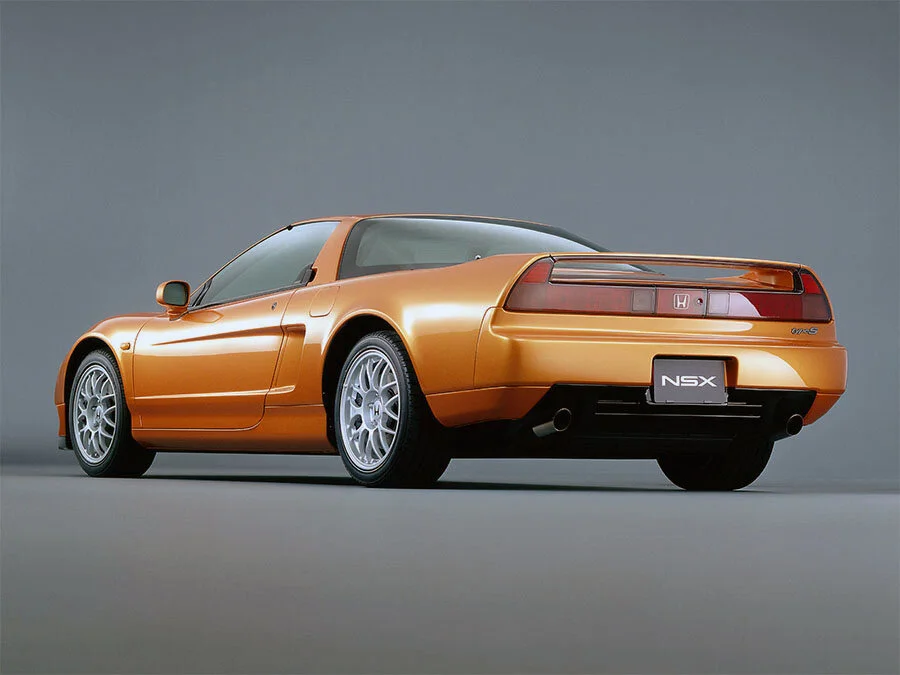Guide: Chasing the F355 - a Historical & Technical Appraisal of the Honda NSX 3.2
/BACKGROUND
By 1997, the European manufacturers that Honda originally targeted with the NSX had regrouped. New models from Ferrari (F355) and Porsche (993) had closed the performance gap and helped re-establish these old world auto makers as the premium brands in the mid-range supercar market.
The F355 and 993 were considerably improved over their predecessors; looks, performance, build quality and ergonomics were a big step up on the 348 and 964 respectively. The NSX had shone a light on the flaws of these early nineties models, but as the decade wore on, Honda found themselves needing to play catch up with the latest generation of machinery.
Their solution was to release a more powerful version of the manual transmission NSX for 1997. It most notably came with an engine enlarged from 3.0 to 3.2-litres and a six instead of five-speed gearbox.
Output was just under 300bhp which was well behind the 380bhp F355 but about on a par with the 993. Nevertheless, the NSX’s sublime handling dynamics ensured it was still one of the most capable and practical supercars on the market.
As usual, buyers could choose from a Coupe or Targa body style.
A four-speed automatic NSX was also offered, but this variant retained the old three-litre engine and was limited to 252bhp (covered separately).
ENGINE / TRANSMISSION
Honda’s new C32B engine was another dual overhead camshaft all-alloy 90° V6. The 78mm stroke and 10.2:1 compression ratio were unchanged but a bore increase from 90mm to 93mm saw displacement rise from 2977cc to 3179cc.
Many other detail alterations were also made to the engine.
It received thinner fibre-reinforced metal cylinder liners, larger intake valves, new head gaskets, larger connecting rod bearings and numerous emission control changes.
The piston pins were increased from 22mm to 23mm diameter and a reconfigured exhaust manifold was made of stainless steel rather than cast iron.
Output rose from 270bhp to 290bhp at an unchanged 7100rpm. There was also more torque on offer with 224lb-ft at 5300rpm compared to 210lb-ft at 6500rpm previously.
In addition to the more powerful and torquier motor, a new six-speed close ratio gearbox further improved performance. It had a reverse gear lockout above 12mph, dual cone synchronisers on third and fourth and a dual-mass low-inertia single plate clutch to handle the extra power.
A limited-slip differential was standard.
CHASSIS
Other mechanical upgrades included bigger brake discs (up from 282mm to 298mm), more refined power steering and improved ABS software.
To clear the new brakes, the spare wheel was increased from a 15-inch to 16-inch diameter.
All five wheels were now painted Blade Silver.
The unchanged unitary chassis was formed from a light and rigid extruded aluminium. The same material was also used for many of the suspension components.
Double wishbones with forged control arms and coil sprung dampers were fitted to each corner along with anti-roll bars at either end.
Seven spoke forged alloy wheels measured 16 x 7-inches at the front, 17 x 8.5-inches at the rear and originally came shod with Yokohama tyres.
As before, a 70-litre fuel tank was retained.
BODYWORK
Cosmetically, little was changed on this latest iteration of the NSX.
To save weight, stronger and lighter body panels were used for the fenders, doors and lids.
Heat absorbing glass was also installed along with a new front spoiler.
There were three new colours for 1997 too: Kaiser Silver, Monte Carlo Blue Pearl and Brooklands Green Pearl.
INTERIOR
Inside, the dash and switchgear were essentially unchanged. The 9000rpm tach and 280kmh speedo were flanked to the left by a water temperature and oil pressure gauge and to the right by a fuel read-out and ammeter.
Bucket seats were well-cushioned and upholstered in leather as was the three-spoke steering wheel. Leather was also used to cover the dash, centre console and doors.
Electric windows, electric mirrors, electric seats and air-conditioning were standard along with driver and passenger airbags.
An immobiliser was now fitted as standard.
While the cockpit many not have had the aesthetic appeal of a premium European exotic, it was undeniably well laid out and finished with top quality materials.
OPTIONS
Keyless entry was a new option for 1997.
Customers could also enhance their cars with a black roof instead of body colour.
Only the targa-topped NSX-T was available in the USA where it was badged as an Acura.
WEIGHT / PERFORMANCE
Although overall weight went up by 10kg (to 1380kg), the C32B engine’s additional output meant this latest NSX had a power-to-weight ratio that was 7% better than its predecessor.
Top speed went from 168mph to 175mph and 0-62mph dropped from 5.5 to 5.3 seconds.
NSX TYPE S & TYPE S-ZERO
At the same time as the 3.2-litre engine was introduced, Honda released a pair of special edition variants for the Japanese Domestic Market.
Like the old Type R (discontinued in September 1995), the NSX Type S and Type S-Zero were designed to appeal to more enthusiastic drivers, those for whom creature comforts were less important than outright performance.
To that end, the Type S and Type S-Zero were enhanced with a number of R-type upgrades.
Both came with carbon-kevlar Recaro bucket seats upholstered in a mixture of alcantara and leather.
Lightweight BBS alloy wheels were fitted along with stiffer suspension, a Momo steering wheel, a titanium shift knob, meshed cooling scoops and a body coloured roof.
The Type S-Zero was even more track focused. It used the thicker Type S rear anti-roll bar with suspension otherwise lifted direct from the Type R. The cruise control, central locking, airbag, air-conditioning, power steering and fog lights were discarded as was much of the sound deadening. Honda fitted a lightweight battery along with 50% thinner partition glass between engine and cockpit.
This weight reduction programme saw the Type S-Zero tip the scales at 50kg less than the Type S. They weighed 1270kg and 1320kg respectively.
1998 PRODUCTION CHANGES
Following the revamped NSX’s introduction, Honda continued their policy of annual improvements.
In 1998, revised software was introduced for the electronic Throttle-By-Wire system.
1999 PRODUCTION CHANGES: ALEX ZANARDI EDITION
In 1999, a special Alex Zanardi Edition was produced exclusively for the US market.
Built to celebrate Zanardi’s 1997 and 1998 CART Indy car titles, these back-to-back championships had been secured by the Honda-powered Chip Ganassi Racing team.
Similar to the Type S, some 51 Alex Zanardi Editions were built, all of which were left-hand drive Coupes.
Each car was painted Formula Red and upholstered in black leather and alcantara with red stitching.
Special equipment included a lightweight rear spoiler, thinner partition glass, lightweight BBS alloy wheels, a lightweight battery and manual rack and pinion steering (instead of power-assisted). An Acura branded airbag steering wheel was installed along with a brushed aluminium plaque on the rear bulkhead that featured the car’s serial number.
50 production cars were built with number 1 going to Zanardi. There was also a number 0 prototype retained by Honda for promotional duty.
Aside from launching the Alex Zanardi Edition, Honda made no changes to the NSX in 1999.
2000 PRODUCTION CHANGES
The year 2000 saw Kaiser Silver, Monte Carlo Blue Pearl and Formula Red discontinued in favour of Silverstone Metallic (silver), Monaco Blue Pearl and New Formula Red.
Door trim panels now came with perforated leather and the ABS was further improved via a software upgrade.
2001 PRODUCTION CHANGES
Nothing was changed for 2001 as Honda worked on a major 2002 overhaul.
2002 PRODUCTION CHANGES
Cosmetically, the 2002 NSX was given a facelift that most notably included an entirely redesigned nose with revised intakes and lighting. Xenon HID headlights were located under clear covers with the fog and side lights clustered alongside.
Stiffer spring rates, a thicker rear anti-roll bar and a quicker steering rack were fitted along with bigger 17 x 7-inch wheels at the front and 17 x 9s at the rear (up from 16 x 7 and 17 x 8.5 respectively).
Two new colours became available (Long Beach Blue Pearl and Imola Orange Pearl). Monaco Blue Pearl was discontinued.
Inside, buyers could now choose Yellow, Silver, Blue, Orange, White or Red upholstery.
The central console, door inserts and instrument bezel were switched to an aluminium finish and white stitching was used on the dash.
Bridgestone Potenza tyres became standard instead of Yokohama A022s.
Thereafter, annual upgrades were limited as the NSX approached the end of its life.
2003 PRODUCTION CHANGES
For 2003, the rear anti-roll bar diameter was enlarged from 17.5mm to 19.1mm.
2004 PRODUCTION CHANGES
In 2004, production switched from Honda’s Takanezawa R&D plant in Tochigi to Suzuka.
Keyless entry and a CD changer were made standard.
The instrument bezels were changed from aluminium to dark grey. The centre console and door trim inserts were switched to a brighter shade of silver.
2005 PRODUCTION CHANGES
2005 saw double synchros added to fifth and sixth gear.
END OF PRODUCTION
NSX production ended on November 30th 2005 by which time over 18,000 had been completed. A successor (the NC1) did not arrive until 2016.
Text copyright: Supercar Nostalgia
Photo copyright: Honda - https://global.honda/






































